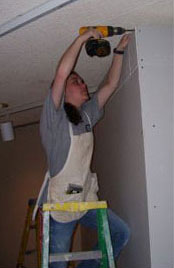
MUSEUM STUDIES
Constructing the Past—with Power Tools by Christina Rodriguez

When I began the Public History Program in the fall of 2005, I was more concerned about my internship than anything else. I had never even looked for or applied for an internship before. The only thing I knew for sure was that I wanted to be at home in Texas for the summer. Austin is not exactly bursting at the seams with history museums, but we have a few really nice ones including the Lyndon B. Johnson Library and Museum. I had always liked that museum so I sent them an e-mail to see if they had anything available for the summer. The curator got back to me and said if I didn't mind coming to work in jeans and a T-shirt and operating power tools, they had a place for me. Jeans and T-shirt sounded fine to me. I was less certain about the power tools, but I chose to have faith in my learning abilities.
The LBJ Library and Museum is a federal institution administered by the National Archives and Records Administration. That means that as soon as I got there in May, I was fingerprinted, background-checked, and thoroughly paper-worked. Once it was determined I was not a threat to national security, it was time to face those power tools.
I was brought on board during the installation phase of a temporary, but major, exhibit called Power to the People: The Electrification of Rural Texas, which is going to be up from September 2006 through May 2007.The exhibit is located in the changing exhibits gallery which is roughly one-third of the fourth floor, so it was a major undertaking. According to the museum's website, "Visitors will journey through time – feeling how tough life was without electricity, seeing how Johnson worked his political will to bring power lines to the region, and understanding the difference electrification made in the lives of Central Texans." Part of that journey included a scene of a pre-electric rural home. The scene is composed of a barn, a cut-away house with a porch, an outhouse, and a fence railing. We built it all with brand new wood, then “rusticated” it to make it look 20 years old.
I spent the majority of my first couple of weeks learning how to frame walls and hang dry-wall. One of my supervisors, Dan, is a professional carpenter and furniture-maker. He spent a lot of time teaching me how to use various tools and especially how to use them safely. Prior to this summer my only experience with power tools was to hold on to a piece of wood while my dad sawed it in half. By the end of the summer, when Dan said, "I need a 6 by, cut 14" with a 45° mitre," I could go to the wood, select the proper size piece, take it to the chop saw, and cut a 14-inch length with a properly mitred edge. I felt amazingly accomplished.
This internship was a lot of hard physical work, which was something I had not expected to encounter in a museum internship, but I loved it. I am so glad I had the courage to try something I had never done before. I learned so much and, even more valuable, I got to experience a major installation, which does not happen often. When I began the program, versatility in my skills was important to me. The internship requirement gave me the opportunity to realize that goal. Plus, if I get tired of museums I can always build houses for a living. I am a master dry-waller after all!